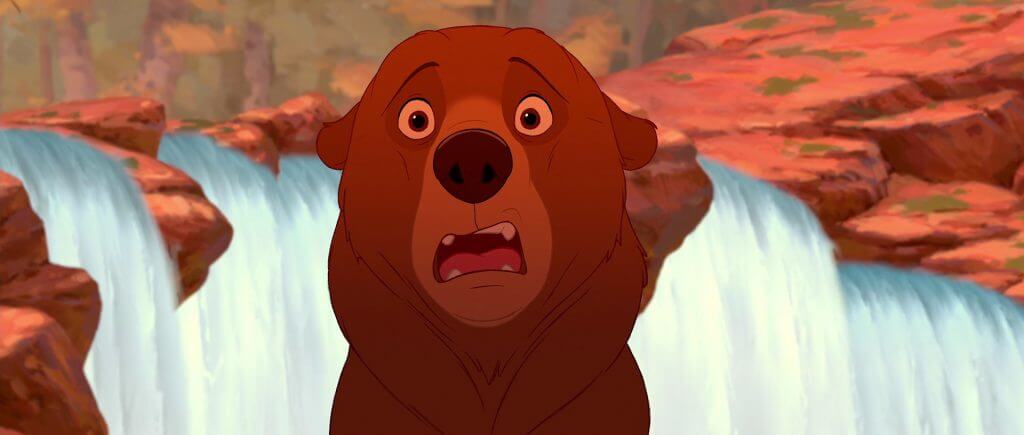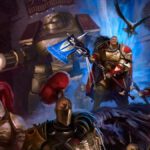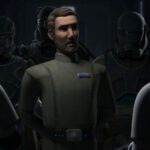REVIEW: Brother Bear (2003)
“You really think love has anything to do with being a man?”
If you know Walt Disney Animation as the studio defined by singing animals and beautiful Princesses, the string of science fiction films they made in the early 2000s may seem random and weird. But in 2003, things were about to get even weirder with the studio’s new release, Brother Bear. This film may have some familiar elements like transformation and animals, but this is another unconventional entry in the canon.
Brother Bear takes place in post-ice age North America with a cast of animals and Inuit people, and a magical aurora containing the spirits, who influence all life and watch over the living. Kenai, the youngest of three human brothers, receives his totem in a coming-of-age ritual, but is disappointed to find it’s the Bear of Love, and his older brother Denahi teases him for it. However, eldest brother Sitka believes in the power of the totems and, along with spiritual leader Tanana, urges Kenai to follow his totem and practice love. In an accident, Sitka falls to his death and Kenai blames a bear they were chasing. The Spirits turn Kenai into a bear to teach him to see through the eyes of another. He befriends a cub named Koda who says he can take him to where the lights touch the Earth to reverse the spell. In growing close to Koda, Kenai must learn the true meaning of love and brotherhood.
Brother Bear has a strange cast to go along with its unconventional premise. Joaquin Phoenix provides the voice of protagonist Kenai, and he’s very good. I wouldn’t put him among the strongest vocal performances in a Disney film, but he’s never distracting or unconvincing. Koda is voiced by Jeremy Suarez, who does a good job sounding like a little kid who’s lost his mother. He’s not really funny, which seems to have been the intention at times, but he’s not actually as annoying as people would have you believe. Sitka is voiced by D.B. Sweeney, who played Aladar in Dinosaur and would go on to voice Avatar Aang in The Legend of Korra. Estelle Harris and Michael Clarke Duncan portray bears in the supporting cast, and Rick Moranis and Dave Thomas annoy as moose brothers Rutt and Tuke. Joan Copeland’s Tanana isn’t poorly acted, but she feels sort of superfluous to the film.

The first five minutes or so of Brother Bear are beautiful and really interesting. We open with Denahi as an old man telling the people of his tribe a story, which turns into the plot of the movie. There is beautiful animation and music in this sequence. As the film flashes back to their youth, the song “Great Spirits” plays. The songs in the film are all written by Phil Collins and Mark Mancina, and this one is performed by Tina Turner. It’s a decent song, but not great and Turner’s voice can be grating at times. The interactions between the three brothers are some of the best parts of the movie. Their relationships are so believable and I wish we could have seen more of them. After Sitka dies Tanana states that he left too soon and that his brothers still need him, and I think this is true of the film as a whole. If Sitka lived longer and we saw him hanging out with his brothers more, his death would be more impactful. I also wonder where their parents are, since they’re never mentioned. We just have three brothers and no indications of any other biological family. It’s really common to have an orphaned protagonist in Disney, but usually we at least know what happened to the parents, or they’re briefly mentioned. Tanana, as I mentioned before, adds nothing to the scenes she is in. She gives Kenai his totem and encourages him to follow it, but we don’t know anything about her and she has no particular bond to any of the characters. She’s also annoying at times, like when Kenai gets turned into a bear and she tells him he will go on a journey and learn about love and perspective. How can she know this? Is she omniscient?
I don’t know much about Inuit mythology, so for all I know this stuff about spirits and animals could be Disney taking creative liberty again, but it works much better in Brother Bear than in Pocahontas, for example. The actual transformation scene is beautiful and I think the concept of turning Kenai into a bear is actually a really good idea. At the heart of this film are a lot of good ideas. After Sitka dies, Kenai is burning with rage, so he kills the bear who he believes is responsible, Koda’s mother. This is extremely dark, and he’s the only Disney protagonist I would describe as a killer. Middle brother Denahi wants nothing to do with Kenai’s revenge for Sitka, but when Kenai is turned into a bear, Denahi believes he has been killed by the bear. Being left alone in the world is what finally sets Denahi off, and he spends most of the film hunting Kenai and Koda. The morality of this film is rather complex for Disney, and for the most part it gives the serious moments the gravitas they deserve. This is also a rarity in that the film has no romance, no yearning for parental approval and no fish out of water subplot for the protagonist. I like that they made a film about brothers, because most Disney films revolve around a parent-child relationship or a couple who fall in love. In fact, this is the only Disney animated film to focus on a man’s relationship to his brothers, although there have been a couple to put that emphasis on sisters.
There are a couple of songs in Brother Bear, that I really like, namely “I’m on My Way,” which is performed by Phil Collins, though Suarez as Koda begins the song. However, “Welcome,” the song that plays in the background when Koda and Kenai arrive at the salmon run, is really annoying. And “No Way Out” is particularly egregious, as it plays over the scene in which Kenai tells Koda the truth about what happened to his mother; this should have been the most powerful moment in the film, but we can’t even hear Phoenix over this sappy song so the drama is lost. We do get some great shots of Koda as he realizes what Kenai is really saying, though; again, really dark stuff here. “Look Through My Eyes” plays over the credits and it’s decent, but it leans to the sappy side too. Overall, the soundtrack to this film is extremely average. The musical score is beautiful, but the songs range from pleasant to distracting. It’s a shame, because Collins and Mancina worked much better as a team on Tarzan.

Overall, I like Brother Bear, but I don’t love it. The relationships between Kenai and his brothers, human and bear, are great. There are segments of animation and music that border on phenomenal. You can almost see the amazing film that’s trying to break out, but it’s hampered by annoying sidekicks and misplaced songs. I actually used to really dislike this film, and I was dreading watching it again for this review. This is probably the animated Disney movie I’ve seen the least. But watching it this time, I realized how much love was poured into it. This isn’t a bad movie and it’s not unwatchable. It’s just frustrating, because with a bit of tweaking this could have been something great. As is, we’re left with a film that’s alright, above average and not without merit. I would recommend Brother Bear if you’re a fan of Disney, animation, or just want to see something different. Again, not one of my favorites but genuinely I’m glad I gave it another look.
Brother Bear
Plot - 8
Acting - 7
Directing/Editing - 5
Music/Sound - 5.9
Animation - 8
6.8
Okay
I like Brother Bear, but I don’t love it. The relationships between Kenai and his brothers, human and bear, are great. There are segments of animation and music that border on phenomenal. You can almost see the amazing film that’s trying to break out, but it’s hampered by annoying sidekicks and misplaced songs.







